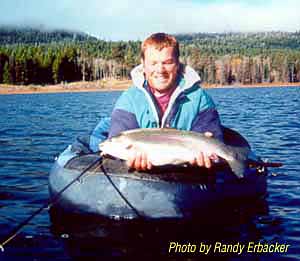|
|

|
Perch: Theyíre ruining
my fishing holes
Jason Webster
Steelheader Contributor
Torn on where I should go fishing, I recalled a conversation I had two
years ago with one of the regional fisheries biologists, Brian Jantz. He was
telling me about the 2000 or so Fraser Valley catchable rainbow trout that
were being stocked in Echo lake near Lumby, and how he has been putting them
into Gardom Lake, near Enderby instead. "By the way," he said, "Iíve had some
good reports, people are doing pretty good out there." Gardom Lake it was, I
thought. I packed up my gear and left immediately.

True to his word, it was shaping up to be a good day at Gardom Lake.
After releasing a fat 3-pound Fraser Valley rainbow, I cast my line out one
more time over the clear blue drop-off and settled my eyes on the small yellow
strike indicator. One minute later the indicator went down and I struck!
"Alright!" I said, anticipating another tussle with a feisty rainbow. But
there was no tussle, my rod vibrated a bit, and it bent over even less! Was it
a small stick or maybe I had snagged a bit of old fishing line? "Oh no" I
gasped, after seeing the creature on the end of my line. "The rumor was true,
Gardom Lake does have perch in it." I cringed with pain. I knew my days of
good trout fishing on Gardom Lake were numbered.
Perch (Perca flavescens) become sexually mature in 4 years and spawn in
the early spring. They are prolific breeders. One 8-inch long female can
produce up to 30,000 eggs compared to a trout of the same size that may
produce 200 eggs. Perch tend to take up residence in the littoral part of a
lake (top 30 feet) and particularly like the shallow weed beds. This area of
the lake is also the most productive part of the lake, almost all the aquatic
insect life is found in the same zone. One can imagine giant schools of 100
Perch or more scouring through the shallows eating every insect in sight. One
can also imagine a poor skinny old trout watching those perch eat all his
dinner. Competition with the trout for food is very much a problem since trout
are insect eaters as well.
According to records, such species as perch, large and smallmouth bass,
pumpkinseed and crappie were first introduced into Washington State around
1890, and soon after made there way into the Okanagan basin. All the species
found the new area hospitable and quickly established themselves in waters
with the most suitable qualities. The two bass species for instance, preferred
the warmer waters of the south Okanagan and are difficult to find north of
Skaha Lake. The Perch, on the other hand, donít mind the cooler temperatures
and are found in the Okanagan system as far north as Kalamalka Lake. From the
larger water bodies, the perch have been illegally introduced to many of the
Okanaganís smaller lakes as well. This is where the problem starts.
Starting in the late 80's, perch were discovered in Pinaus Lake, south of
Falkland. About 5 years later they showed up in Lambly (Bear) Lake, above the
west side of Okanagan Lake. About 2 years after that, they were discovered in
Yellow Lake, west of Penticton, and now have been discovered in Gardom Lake,
north west of Enderby. All of these lakes had been "trout only" lakes for
years with the exception of Gardom Lake, which had a few species of minnows
existing in it.
Perch are not known for their upstream swimming ability, so the idea that
they swam up the creeks from Okanagan Lake can be ruled out. It is possible
that a fisherman may have brought some live perch up to the lake as bait to
catch trout; the Perch then got off the hook and took up a new home, but that
is unlikely. The most sensible, or should I say insensible theory of how perch
got to these trout lakes is that someone placed them there deliberately. Why?
So they could catch and eat them. Perch are excellent tasting fish but are
also boring sport and will bite almost anything that moves.
So there is every indication that it is people that are bringing these
prickly yellow nuisances into my favorite trout lakes. And as a result of
these actions, the hardy perch have seriously damaged the trout population.
All I can say is that if anyone out there is thinking of introducing
perch into a local lake, think again. For one thing, if I catch you doing it,
I may be tempted bleep. . . bleep. . . bleep. And for another thing, these
lakes were designed to be trout lakes.
Thousands of dollars are spent by the Provincial Fish Culture Section to
raise trout fry and stock them into lakes. Surely we don't want these dollars
gobbled up by an unwanted species. Contrary to what you may have heard, the
majority of fishermen do not plan their weekend around hunting down the "wily"
perch.
Let's keep those pesky invaders out of our remaining trout lakes.
The next time I go fishing and hook on to a snag from a clear blue lake,
I 'd rather it was an old running shoe than a prickly perch or, for that
matter, a poor old skinny trout.
-
|
|
|